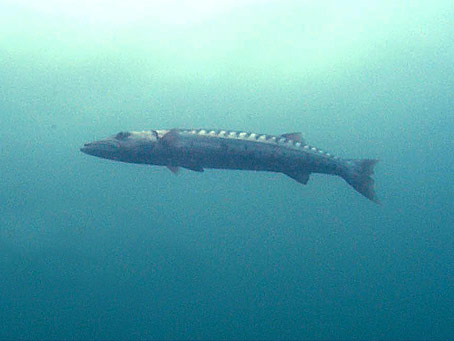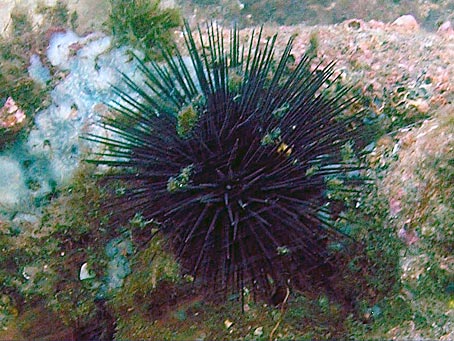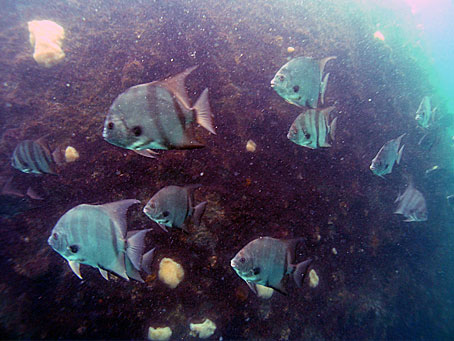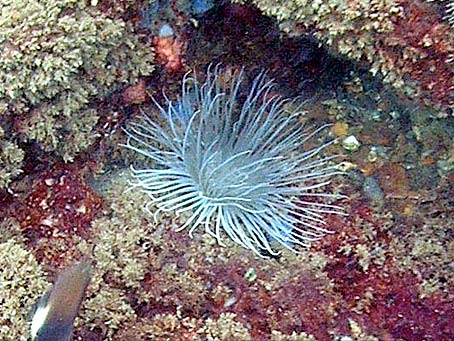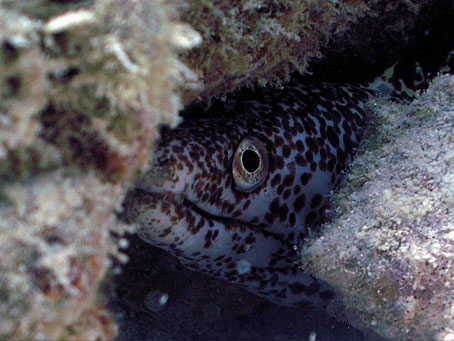This video contains images of the following marine life: Great Barracuda, Silversides, Spadefish, Butterflyfish, Grunts, Jellyfish, Jacks, and Scads. This video presents a fraction of the diverse marine life that calls USS Massachusetts home.
Angelfish – Angelfish come in a variety of colors, from grey and yellow to green, blue, and yellow, to black and yellow, banded, and plain. One identifiable feature of angelfish is the square pectoral fin. Angelfish often swim around the reefs in pairs, so if you see one, look for its mate.
bio1.jpg
Angelfish
Spotfin Butterflyfish – Spotfin Butterflyfish are often distinguished by their bright yellow fins and black stripe across their head and eyes. They have a silver-white body and have a small black dot on the outer edge of their rear dorsal fin.
bio2.jpg
Spotfin Butterflyfish
Great Barracuda – The Great Barracuda has a long, sliver, cylindrical body with a large underslung jaw, pointed teeth, and scattered dark blotches along the body. This fish will drift around reefs and shipwrecks and often follow divers in search of food or curiosity, but it will not harm you. Don’t be alarmed if you continually see the fish opening and closing its mouth, it needs to do this to assist with respiration.
bio3.jpg
Great Barracuda
Grunts – The common family name, Grunt, comes from the sound the fish make when they grind their teeth together which becomes amplified by their air bladder. Most of the fish in the Grunt family are colorful, and drift in schools throughout the shallow reefs during the day and feed at night.
bio4.jpg
Grunts
Jacks – Jacks are silvery fish that like to swim in schools but can occasionally be found alone or amongst other schools of fish. You can often find them in open water over reefs and shipwrecks or feeding amongst the goatfishes and shadow stingrays.
bio5.jpg
Jacks
Blue Tangs – similar to Doctorfish, the Blue Tang can change from bluish gray to dark brown as an adult and be bright yellow as a juvenile. They will be found on reefs and are often seen head down eating algae.
bio6.jpg
Blue Tangs
Remora – Remoras or sharksucker are long fish that have foredorsal fin which has been modified to form a sucking disc on top of their head. This unusual fin allows for the fish to attach itself to the host and travel with ease. They are often found attached to sharks, rays, large fish, turtles, boats and even divers!
bio7.jpg
Remora
Sea Urchins – Be careful when you see these! The Urchin has short, thick, pointed spines that hurt when you touch them. They are often Black to reddish-brown to purple. Urchins are often found in shallow rocky areas but can sometimes be found in deeper waters.
bio8.jpg
Parrotfish
Spadefish – Spadefish have body shape that resembles a “spade,” hence its name. These fish are generally Silvery-grey in color with numerous black stripes running vertically along their body. Spadefish often swim in small schools in open water, but they are not shy around Massachusetts, you can see them swimming throughout the shipwrecks.
bio9.jpg
Spadefish
White anemones - Anemones can come in multiple colors and either living in a colony or alone. The body of an Anemone looks like a bouquet of tentacles with slightly enlarged tips that may be a slightly different color from the body of the tentacle. The anemone is not considered toxic to the human touch but it may sting a little or irritate the skin if you brush up against it.
bio10.jpg
White anemones
Moray Eels - Moray eels can come in various colors, those found around Massachusetts often have speckles of dark brown amongst a creamy white. They are often found in shallow reefs, rocky areas, and under shipwreck debris. Eels often open and close their mouths, do not worry, this isn’t to hurt you, it is an action required for respiration.
bio11.jpg
Moray Eels


